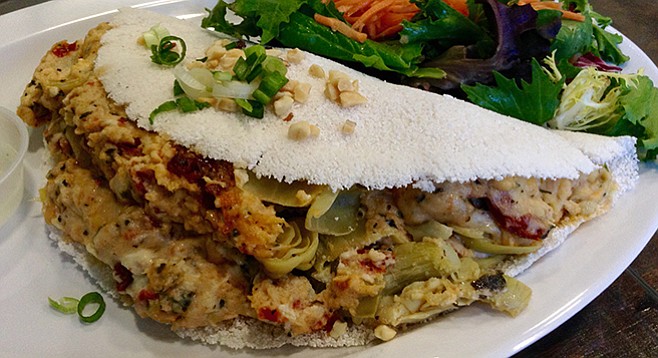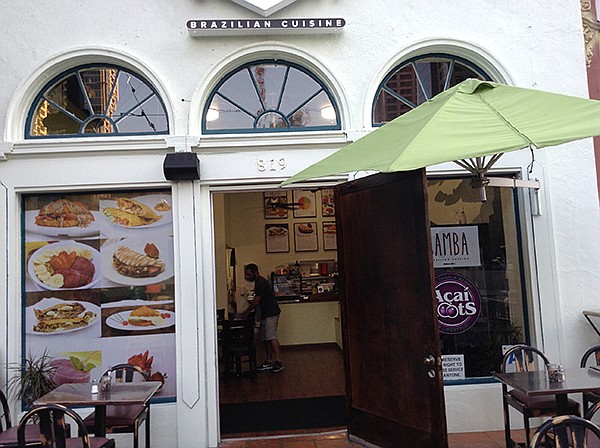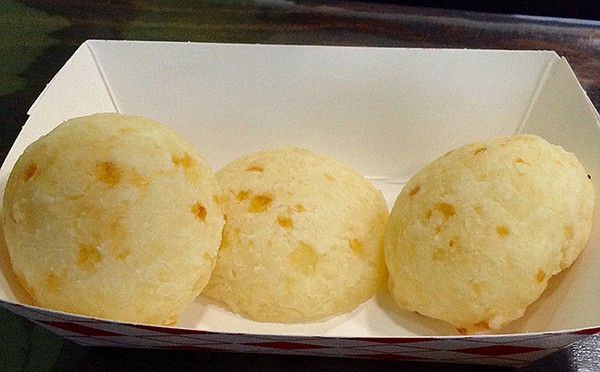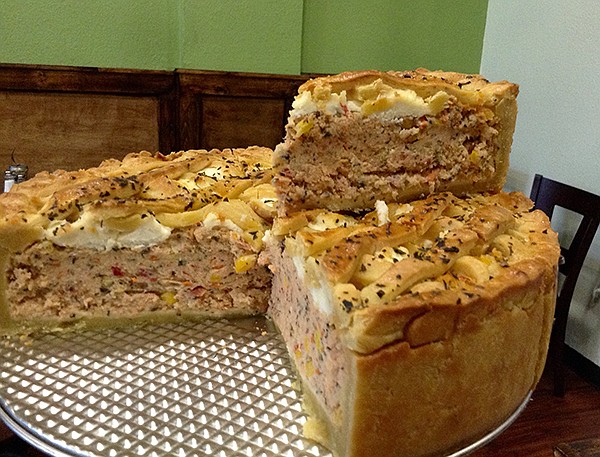 Facebook
Facebook
 X
X
 Instagram
Instagram
 TikTok
TikTok
 Youtube
Youtube



Frog spawn?
Oh, no. I stare at my bowl.
“Eat your tapioca!”
This is grandma, standing over the table, back in the day. The treat we kids always dreaded: tapioca pudding that looked like frog spawn.
It all comes rushing back as I stare at this menu here. “Tapioca crêpe,” it reads.
“It’s really popular in Brazil,” says Juliano. “And we’re the first place in San Diego to have it.”
His place is named “Samba,” and it’s right here downtown, in a little clump of cafés that look out to where red trolleys rumble past every few minutes.
This one is right where a sign reads, “Sidewalk Closed,” because the Churchill Hotel next door is being gutted and turned into low-income apartments. The Churchill’s a survivor: it opened 100 years ago (1914, actually — for the Panama-California Exposition).
The fact is, I worried for these guys’ survival the moment I saw their new sign go up. Not enough foot traffic here between downtown and City College.

But Samba looks like it means business. They’ve given the façade a pale green paint job, spruced up the patio with lime-green umbrellas, and covered the off-white and green walls inside with photos by local artists and have even slung a gnarly woven-wood longboard above the entrance.
First nice surprise: you get a frosty glass of water flavored with lemon and mint as soon as you sit down.
Then I start to wonder, what the heck is Brazilian food? Brazil is so huge you’ve got pampas and you’ve got jungle. I mean, where do you start?
“Street food,” says Juliano. “That’s what we do. We’re the only Brazilian place that does everyday Brazilian street food: the beans and rice and tapioca and monkfish and chicken and eggplant parmigiana and beef strip, things that are comfort food for any Brazilian. And there are 37,000 of us living in San Diego.”
He says he and his partner started off in the farmers’ markets here, serving Brazilian street dishes like coxinhas, Brazilian chicken croquettes, and pão de queijo (cheese bread). Now that they’ve come here, they can expand the choices.
He hands me the menu. The main deal is the “House Speciality.” It has 15 versions. All cost the same: $7.
Deal!

“Step 1,” it says. “Choose your pastry.” Like, what you’re going to wrap your food in. You’ve got pastel, meaning a kinda bready panini wrap. Then you’ve got the “tapioca crêpe,” or you can use a split croissant.
It’s the tapioca crêpe that grabs me, I guess because of granny. Added benefit: this tapioca ain’t mushy and sweet. It’s crispy. Actually looks like a snowy covering of polystyrene chips.
“This is popular all over Brazil,” Juliano says. “Because tapioca is just healthier. And it’s our native food. Tapioca is a Brazilian plant.”
’Course, tapioca’s just the shell. Now I’ve got to choose what to stuff into it. So, Step 2: “Choose your filling.” You get 15 combo choices, like the “Paulista,” which is chicken stroganoff and mushrooms topped with “shoestring potato chips.” Or the “Gaucho,” seasoned ground beef, green sliced olives and cheese (you can choose from mozzarella, cheddar queso fresco, ricotta, or cream cheese). Or “Amazonas,” sliced hearts of palm tree with oregano, roasted red bell pepper, and cheese. Or the “Curitiba” (smoked sausage, sliced onions, and cheese). Or the “Floripa” (spinach, bell pepper, corn, cheese). Or even the “San Diego,” where you just go ahead and build your own.

I opt for the “Brasilia,” which is basically vegetarian (it has artichoke, cheese, pesto, nuts, and sun-dried tomatoes). Except the whole purity thing breaks down when I ask for protein, in the form of chicken ($1 extra), just because I’m hungry, and Mauricio, the guy helping Juliano today, says it really makes this crêpe sing.
And, OMG, he’s right. The crispy-crunchy tapioca shell is the first totally new thing I’ve had in ages. Plus, the mess of artichoke, nuts, the crispy melted mozzarella, the chicken chunks...I mean, it’s huge. You get a nice side salad with it, too.
Is it my imagination? I’m feeling I’m getting a feeling for the slightly jungly flavors that have grown out of that giant chunk of South America they call Brazil.
Pretty soon, Mauricio and Juliano are teaching me to sing the “Girl from Ipanema” in Portuguese (“Garota de Ipanema”). This is when a girl comes in speaking Portuguese. Deyse. Brazilian. “I’m studying English here,” she says.
Also, turns out she comes from Manaus, that fabled city in the middle of the Amazonian jungle. “La garota de Manaus!” says Juliano. “She comes in every day for her comfort food, right?”
“Right,” says Deyse.
Man. Love the atmosphere. Juliano brings around samples of coxinhas (creamy little deep-fried spud-chicken-cream-cheese combos) and pão de queijo (bite-sized cheese breads like mini flying saucers) that they make for customers. Now I’m determined to come back for their lunch buffet.

You get the feeling that Brazilian food is basically a bunch of local plays on European foods, specially Italian and Portuguese, just because so many immigrants came from there. Fun starts when you throw in local foods like açaí and tapioca, both from the Amazonian area of Brazil. They call tapioca “Brazilian arrowroot.”
Now, it seems half the world depends on tapioca. And bubble tea shops everywhere have given it a new lease on life.
And probably every granny in the world still does what mine did. Forcing that frog spawn down innocent young throats.
Sigh. If she had only given us tapioca crêpe.
Prices: Açaí bowl, $7; two coxinhas (potatoes stuffed with chicken, cream cheese), $5; Brazilian pot pie, salad, $8.50; house specialty (choice of 15 fillings, three wraps including tapioca crêpe), including the Paulista (chicken stroganoff, mushrooms, shoestring potatoes), $7; the Gaucho (ground beef, olives, cheese), $7; Amazonas (hearts of palm, bell pepper, cheese); the Curitiba (smoked sausage, onions, cheese), $7; the Brasilia, (artichoke, cheese, pesto, nuts, dried tomatoes), $7; lunch buffet (beef, chicken, pork or fish with grains, salads, veggies), $8.90
Hours: 11:00 a.m. to 6:00 p.m., Monday–Thursday; 11:00 a.m. to 9:00 p.m. Friday, Saturday; closed Sundays
Buses: All downtown
Nearest bus stops: Broadway and 9th
Trolleys: Orange and Blue Lines
Nearest trolley stop: City College




Frog spawn?
Oh, no. I stare at my bowl.
“Eat your tapioca!”
This is grandma, standing over the table, back in the day. The treat we kids always dreaded: tapioca pudding that looked like frog spawn.
It all comes rushing back as I stare at this menu here. “Tapioca crêpe,” it reads.
“It’s really popular in Brazil,” says Juliano. “And we’re the first place in San Diego to have it.”
His place is named “Samba,” and it’s right here downtown, in a little clump of cafés that look out to where red trolleys rumble past every few minutes.
This one is right where a sign reads, “Sidewalk Closed,” because the Churchill Hotel next door is being gutted and turned into low-income apartments. The Churchill’s a survivor: it opened 100 years ago (1914, actually — for the Panama-California Exposition).
The fact is, I worried for these guys’ survival the moment I saw their new sign go up. Not enough foot traffic here between downtown and City College.

But Samba looks like it means business. They’ve given the façade a pale green paint job, spruced up the patio with lime-green umbrellas, and covered the off-white and green walls inside with photos by local artists and have even slung a gnarly woven-wood longboard above the entrance.
First nice surprise: you get a frosty glass of water flavored with lemon and mint as soon as you sit down.
Then I start to wonder, what the heck is Brazilian food? Brazil is so huge you’ve got pampas and you’ve got jungle. I mean, where do you start?
“Street food,” says Juliano. “That’s what we do. We’re the only Brazilian place that does everyday Brazilian street food: the beans and rice and tapioca and monkfish and chicken and eggplant parmigiana and beef strip, things that are comfort food for any Brazilian. And there are 37,000 of us living in San Diego.”
He says he and his partner started off in the farmers’ markets here, serving Brazilian street dishes like coxinhas, Brazilian chicken croquettes, and pão de queijo (cheese bread). Now that they’ve come here, they can expand the choices.
He hands me the menu. The main deal is the “House Speciality.” It has 15 versions. All cost the same: $7.
Deal!

“Step 1,” it says. “Choose your pastry.” Like, what you’re going to wrap your food in. You’ve got pastel, meaning a kinda bready panini wrap. Then you’ve got the “tapioca crêpe,” or you can use a split croissant.
It’s the tapioca crêpe that grabs me, I guess because of granny. Added benefit: this tapioca ain’t mushy and sweet. It’s crispy. Actually looks like a snowy covering of polystyrene chips.
“This is popular all over Brazil,” Juliano says. “Because tapioca is just healthier. And it’s our native food. Tapioca is a Brazilian plant.”
’Course, tapioca’s just the shell. Now I’ve got to choose what to stuff into it. So, Step 2: “Choose your filling.” You get 15 combo choices, like the “Paulista,” which is chicken stroganoff and mushrooms topped with “shoestring potato chips.” Or the “Gaucho,” seasoned ground beef, green sliced olives and cheese (you can choose from mozzarella, cheddar queso fresco, ricotta, or cream cheese). Or “Amazonas,” sliced hearts of palm tree with oregano, roasted red bell pepper, and cheese. Or the “Curitiba” (smoked sausage, sliced onions, and cheese). Or the “Floripa” (spinach, bell pepper, corn, cheese). Or even the “San Diego,” where you just go ahead and build your own.

I opt for the “Brasilia,” which is basically vegetarian (it has artichoke, cheese, pesto, nuts, and sun-dried tomatoes). Except the whole purity thing breaks down when I ask for protein, in the form of chicken ($1 extra), just because I’m hungry, and Mauricio, the guy helping Juliano today, says it really makes this crêpe sing.
And, OMG, he’s right. The crispy-crunchy tapioca shell is the first totally new thing I’ve had in ages. Plus, the mess of artichoke, nuts, the crispy melted mozzarella, the chicken chunks...I mean, it’s huge. You get a nice side salad with it, too.
Is it my imagination? I’m feeling I’m getting a feeling for the slightly jungly flavors that have grown out of that giant chunk of South America they call Brazil.
Pretty soon, Mauricio and Juliano are teaching me to sing the “Girl from Ipanema” in Portuguese (“Garota de Ipanema”). This is when a girl comes in speaking Portuguese. Deyse. Brazilian. “I’m studying English here,” she says.
Also, turns out she comes from Manaus, that fabled city in the middle of the Amazonian jungle. “La garota de Manaus!” says Juliano. “She comes in every day for her comfort food, right?”
“Right,” says Deyse.
Man. Love the atmosphere. Juliano brings around samples of coxinhas (creamy little deep-fried spud-chicken-cream-cheese combos) and pão de queijo (bite-sized cheese breads like mini flying saucers) that they make for customers. Now I’m determined to come back for their lunch buffet.

You get the feeling that Brazilian food is basically a bunch of local plays on European foods, specially Italian and Portuguese, just because so many immigrants came from there. Fun starts when you throw in local foods like açaí and tapioca, both from the Amazonian area of Brazil. They call tapioca “Brazilian arrowroot.”
Now, it seems half the world depends on tapioca. And bubble tea shops everywhere have given it a new lease on life.
And probably every granny in the world still does what mine did. Forcing that frog spawn down innocent young throats.
Sigh. If she had only given us tapioca crêpe.
Prices: Açaí bowl, $7; two coxinhas (potatoes stuffed with chicken, cream cheese), $5; Brazilian pot pie, salad, $8.50; house specialty (choice of 15 fillings, three wraps including tapioca crêpe), including the Paulista (chicken stroganoff, mushrooms, shoestring potatoes), $7; the Gaucho (ground beef, olives, cheese), $7; Amazonas (hearts of palm, bell pepper, cheese); the Curitiba (smoked sausage, onions, cheese), $7; the Brasilia, (artichoke, cheese, pesto, nuts, dried tomatoes), $7; lunch buffet (beef, chicken, pork or fish with grains, salads, veggies), $8.90
Hours: 11:00 a.m. to 6:00 p.m., Monday–Thursday; 11:00 a.m. to 9:00 p.m. Friday, Saturday; closed Sundays
Buses: All downtown
Nearest bus stops: Broadway and 9th
Trolleys: Orange and Blue Lines
Nearest trolley stop: City College